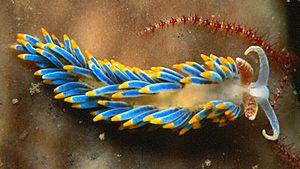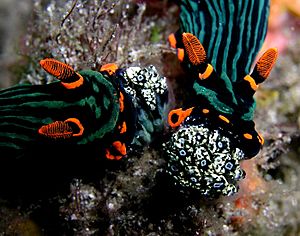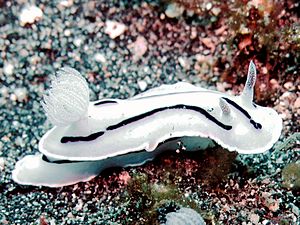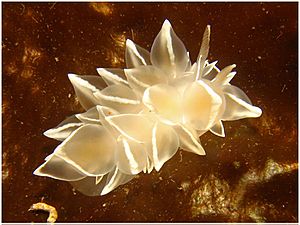Nudibranch facts for kids
Quick facts for kids Nudibranch |
|
|---|---|
 |
|
| Berghia coerulescens | |
| Scientific classification | |
| Kingdom: | |
| Phylum: | |
| Class: | |



Nudibranchs are a type of mollusc that lives in the sea. They are also known as sea slugs. The name "nudibranch" means 'naked gills'. This is because they do not have a shell like many other molluscs. Instead, their gills are often visible on their bodies.
Nudibranchs are famous for their bright and beautiful colors. There are more than 3,000 known species of nudibranchs. They come in many different shapes and sizes.
Contents
About Nudibranchs
Nudibranchs are part of a group called opisthobranchs. This means they lose their shells after they are born as larvae. Unlike most other molluscs, nudibranchs have bodies that are the same on both sides. This is called bilateral symmetry.
What Nudibranchs Eat
Most nudibranchs are carnivores, meaning they eat other animals. They have a simple gut and a mouth with a special scraping tongue called a radula.
- Some nudibranchs eat sponges.
- Others eat polyps, which are tiny animals like corals.
- Some eat other sea slugs or even members of their own species.
- Other groups eat tunicates, barnacles, or anemones.
One special nudibranch, Glaucus atlanticus, lives on the surface of the water. It eats dangerous jellyfish like the Portuguese man o' war. This nudibranch sucks air into its stomach to float. It uses its strong foot to hold onto the water's surface. If it finds a small victim, Glaucus simply eats it whole. If the prey is larger, it nibbles off the stinging parts.
Amazing Colors and Defense
Nudibranchs are some of the most colorful creatures on Earth. Since they do not have a shell for protection, they have developed other ways to defend themselves.
- Camouflage: Some nudibranchs blend in with their surroundings. Their bodies look like the plants or rocks around them. This helps them hide from predators.
- Warning Colors: Many nudibranchs have very bright and intense colors. These colors warn predators that the nudibranch is distasteful or poisonous. This is called warning coloration.
- Stinging Cells: Some nudibranchs eat animals called hydroids. Hydroids have stinging cells called nematocysts. The nudibranchs can store these stinging cells in their own bodies. They move the cells from their gut to their skin. Then, they use these stolen stinging cells to protect themselves!
- Sour Liquid: Another way nudibranchs protect themselves is by releasing a sour liquid from their skin. If a predator touches or irritates them, they automatically release this slimy liquid.
- Using Plant Power: Some nudibranchs can even take chloroplasts from plants they eat. Chloroplasts are parts of plant cells that make food using sunlight (photosynthesis). The nudibranchs can use these chloroplasts to make their own food!
Different Kinds of Nudibranchs
Scientists are still studying how to group all the different types of nudibranchs. But generally, nudibranchs are divided into two main kinds: dorid nudibranchs and aeolid or eolid nudibranchs.
- Dorid Nudibranchs: These nudibranchs have a feathery cluster of gills on their back, usually near their rear end. This cluster is called a branchial plume.
- Aeolid Nudibranchs: Instead of a branchial plume, aeolids have many finger-like parts on their backs called cerata. These cerata help them breathe and can also be used for defense. Some aeolids even host tiny plant-like organisms called zooxanthellae inside their cerata. These zooxanthellae make food using sunlight, which helps the nudibranch.
Images for kids
-
Pteraeolidia ianthina has adapted cerata to house symbiotic zooxanthellae obtained from its diet, which continue to photosynthesize and provide energy to the nudibranch.
-
Clown nudibranch Triopha catalinae, Northern California.
-
Chromodoris annae from Lembeh Straits, Indonesia.
-
Goniobranchus kuniei, off the coast of Papua New Guinea.
See also
 In Spanish: Nudibranquios para niños
In Spanish: Nudibranquios para niños





























